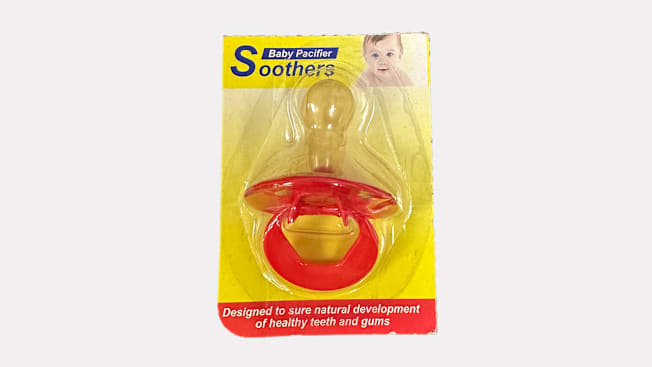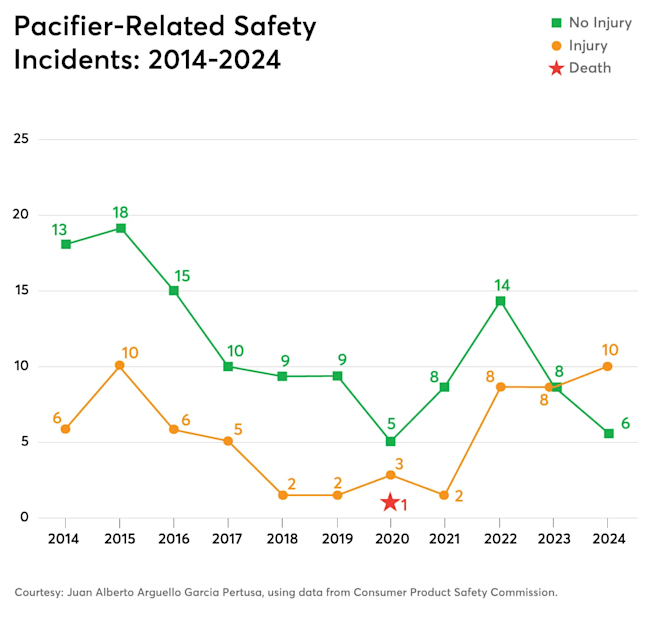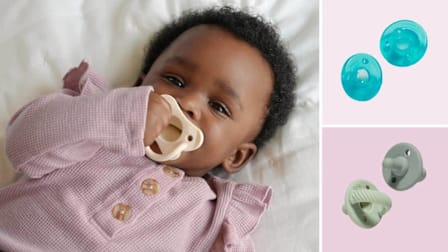How Safe Is Your Baby's Pacifier?
We talked to experts about tips for where to buy and not buy, what to know about pacifiers and breastfeeding, and how pacifiers may impact your child’s future teeth

Pacifiers, like diapers and onesies, are a staple on every new parent’s checklist, ready and waiting when baby comes home. We parents rely on pacifiers to help our babies self-soothe and sleep more soundly, and to distract them from uncomfortable experiences like getting a vaccination or blood test. The American Academy of Pediatrics also recommends using pacifiers at naptime and bedtime as a way to reduce the risk of sudden infant death syndrome, or SIDS.
CR recently tested 20 pacifiers—representing a cross-section of a very large market—in our labs for structural integrity, choking hazards, harmful chemicals, and other safety concerns. Most of the pacifiers we tested performed very well in our tests, although we discovered that a few had potentially risky attachments or confusing labeling issues.
Parents shopping for pacifiers should be aware that while all pacifiers sold in the U.S. are subject to strict safety regulations, unsafe pacifiers can and do make it into the marketplace. Here’s what you need to know and what experts say about safe pacifier use.
How Safe Are Pacifiers?
The good news is that strict and comprehensive pacifier standards exist in the U.S. and are enforced by the Consumer Product Safety Commission. Under federal safety rules, pacifiers sold in the U.S. must meet specific requirements regarding their guard and shield, ventilation holes, nipple strength, and more. They also aren’t allowed to have detachable small parts that can pose choking hazards.
Additionally, in 2008, the Consumer Product Safety Improvement Act was passed, and this added additional surface coating requirements, lead and phthalate content limits, requirements under the mandatory toy standard, testing and certification, and tracking label requirements. The CPSIA also requires that children’s products meeting a mandatory standard be tested by an accredited third-party laboratory approved by the CPSC.
Best Pacifiers From Our Tests
We analyzed, boiled, stretched, poked, and squeezed 20 pacifiers for hazards and harmful chemicals.
How Unsafe Pacifiers Can Enter the Marketplace
On eBay, you can purchase used pacifiers ranging from vintage designs to nearly 20-year-old ones. (The AAP warns that pacifiers fall apart over time and that some manufacturers have expiration dates that should be adhered to, so buying an old design to save money or appeal to your love for vintage isn’t a safe choice.) On Amazon, glitzy rhinestone-encrusted pacifiers are sold by unknown manufacturers like Luqeeg and Bnineteenteam Store. In the past, the CPSC has recalled pacifiers that contain Swarovski crystals because the crystals can separate easily and pose aspiration and ingestion hazards. CR’s experts caution against using pacifiers with rhinestones or crystals because they pose a choking hazard.
The CPSC’s rule says that a pacifier should not be sold or distributed with any ribbon, string, cord, chain, twine, leather, yarn, or similar attachments due to strangulation hazards, and that the length of clips should not exceed 7 to 8 inches. Yet we found several pacifiers on Amazon and other online shopping sites sold with stuffed animals or chains (some of which exceeded the suggested length), as well as pacifier clips that are sold alone but are made from materials like ribbon and beads.
Parent communities are popular on social media apps like Facebook and WhatsApp, and some of them also allow parents to make and save money by selling, buying, and donating secondhand baby products. It’s one thing to be the lucky recipient of an unopened pack of pacifiers that your neighbor’s toddler didn’t use after weaning, and another to take chances with pacis in suspicious packaging. It’s never a good idea to purchase used or secondhand pacifiers that are not in their original packaging and cannot be verified as following pacifier standards. “I often see unsafe baby products in my parents’ WhatsApp buy-sell-give group,” says CR’s Angela Lashbrook. “People sell pacifiers all the time. Sometimes they list the brand. Sometimes they don’t.”
We Analyzed, Boiled, Stretched, Poked, and Squeezed 20 Pacifiers for Hazards and Harmful Chemicals
And we have some very good news for stressed-out parents. Read the results of CR’s rigorous pacifier testing.
CR asked Amazon, eBay, and Meta (which owns Facebook and WhatsApp) for comment about potentially unsafe pacifiers sold on their sites. Meta did not respond in time for publication.
Amazon told CR that it requires all pacifier clips sold in its store to comply with applicable regulations. The company says it develops “innovative tools to prevent noncompliant or unsafe products from being listed in our store, including robust seller vetting programs and advanced machine learning detection combined with expert human investigators. We continuously monitor our store, and if we discover a product was undetected, we address the issue immediately and refine our controls.” CR confirmed at the time of publication that all of the pacifier clips CR found on Amazon have been removed from its site.
CR also asked Amazon how it handles potentially dangerous pacifiers sold on its site, such as those with rhinestones. CR’s experts could not find explicit language in the CPSC rule prohibiting the use of rhinestones. Amazon responded that it requires pacifiers to comply with CPSC requirements for small parts and that it closely monitors CPSC guidance for policy updates and product recalls and warnings, in addition to other product safety signals such as customer feedback and manufacturer notices. At the time of publication, the rhinestone pacifiers remained for sale.
A spokesperson from eBay responded that eBay prioritizes consumer safety and has removed the reported listings while continuing to take down similar items in line with its product safety policy (at the time of publication, the listings were still up). The spokesperson also said that in 2024, eBay’s safety systems, which are powered by product safety filter algorithms, audits, and regulator partnerships, blocked over 40 million potential violations to keep its marketplace secure.
Pacifier safety isn’t just an online shopping issue, either.
Consumer Reports’ José Amézquita, who tested pacifiers in our labs, found the pacifier shown below selling for $2.07 in a small neighborhood store in the Bronx. According to Amézquita, it lacked labeling requirements for pacifiers. This is just one example that points to a potentially larger concern: off-brand pacifiers appearing in local stores, which can pose safety risks to families in those communities.

Photo: Consumer Reports Photo: Consumer Reports
Counterfeit Pacifiers
In September 2020, U.S. Customs and Border Protection (CBP) officers in Pittsburgh seized a shipment of 25 counterfeit pacifiers from Hong Kong. The pacifiers featured bejeweled Chanel and Mercedes-Benz logos, metallic link chains, and clips. CR contacted the CBP to find out how many counterfeit pacifiers or pacifiers that violated consumer protection safety laws had been seized at U.S. borders since 2020, and the results are surprising.
Between 2020 and March 2025, there were seven pacifier seizures. The first, in 2020, involved counterfeit products. The remaining six seizures were due to violations of consumer safety laws enforced by the Consumer Product Safety Commission. In total, 2,031 pacifiers were confiscated. The two largest seizures occurred in New Orleans—625 pacifiers from China were seized in 2022, and 974 more Chinese pacifiers were seized in 2023.
Gabe Knight, a CR senior policy analyst, stresses the vital role that the CPSC plays in protecting the public from unreasonable risks of injury or death associated with over 15,000 different types of products, including baby products like pacifiers.
“The CPSC creates and enforces safety standards to keep babies safe and prevent unsafe baby products from making their way into families’ homes,” Knight says. “In a market increasingly dominated by online shopping, this work is more important than ever. The CPSC also needs retailers and online marketplaces to be cooperative partners in safety, especially by clamping down on the presence of misleading or dangerous products on their platforms.”
Knight adds that the CPSC also works to stop dangerous or illegal products at U.S. ports of entry before they can enter consumers’ homes. “This work is especially important for products that enter the U.S. in large quantities at a time, and pacifiers certainly qualify,” Knight says.
How Common Are Pacifier Injuries?
From 2014 to 2024, the CPSC received reports of 178 pacifier incidents—to put this into context, that’s fewer than 18 reported incidents each year. (By contrast, in 2023, the CPSC reported an estimated 60,400 nursery-product-related injuries among children younger than 5 treated in emergency departments, and 64 percent of them were associated with high chairs, cribs/mattresses, infant carriers, and strollers/carriages). Of the 178 pacifier reports, one child died, 62 involved injuries, and 115 did not. “Non-injuries” can include reported problems with the pacifier’s design or incidents in which the pacifier was broken or faulty but did not injure the child.
Trends in pacifier safety reports over time indicate a rise in recent years, however. Pacifier-related safety incidents reported to the CPSC peaked in 2015 and then steadily declined over the following years, reaching a low of nine in 2020. However, the trend reversed, with reports rising from 10 in 2021 to 22 in 2022. It then decreased again to 16 in 2024—which is still nearly as high as the average number of incidents per year.

According to the CPSC’s SaferProducts.gov database, examples of injuries include babies choking after getting pacifiers stuck inside their mouth, babies getting their fingers stuck in the pacifier’s small ventilation holes and losing circulation or being rushed to the emergency room, and babies biting off parts of the pacifier, such as the nipple. In CR’s lab tests, only three out of 20 pacifiers didn’t break when we exerted the most force on them during bite tests. The three most durable pacifiers had nipples made from natural rubber (not silicone) and were designed for ages 0 and up, and 0 to 6 months.
While there fewer reported pacifier-related injuries every year than there are for other children’s products, parents should still follow expert guidance on safe pacifier use to help prevent the rare but potentially serious injuries that can occur.
Pacifier Safety Tips
There are several good reasons to give your baby a pacifier—for example, offering your baby a pacifier at naptime and bedtime can help reduce the risk of sudden infant death syndrome, according to the American Academy of Pediatrics. Here are some helpful tips from the AAP and experts we consulted on using a pacifier safely.
• The AAP recommends looking for a one-piece pacifier with a soft nipple that is dishwasher-safe.
• Adhere to a manufacturer’s recommended ages for use. (A too-small pacifier is a choking hazard for a toddler, and a too-large one can overwhelm a newborn.)
• Boil the pacifier or run it through the dishwasher before your baby uses it. Make sure you squeeze the nipple with clean hands to release any trapped water.
• Follow the manufacturer’s instructions for cleaning your pacifier. If instructions aren’t given, the AAP recommends boiling/putting it in the dishwasher frequently until your baby is 6 months old; after that, you can regularly wash it with soap and rinse it in clear water.
• Do not use the nipple from a baby bottle as a pacifier (this can be a choking hazard).
• Do not use a pacifier to replace or delay meals.
• Never tie a pacifier to a child’s crib or around their neck or hand.
• Follow the manufacturer’s expiration date.
• Inspect pacifiers often and toss your baby’s paci if it shows signs of damage, cracking, or discoloration.
What to Know About Pacifiers and Breastfeeding
Many parents have two pressing concerns about pacifier use: Will pacifiers interfere with breastfeeding, and can they damage a baby’s teeth? Let’s clear up any misconceptions.
CR contacted Maya Bunik, MD, MPH, professor of pediatrics and chair of the section on breastfeeding at AAP, who directed us to the Tech Report AAP 2022. According to the report, giving healthy, full-term babies pacifiers (either before or after breastfeeding is well established), doesn’t shorten how long they breastfeed during the first four months of life. However, there isn’t enough information yet to determine for certain any potential downsides for babies or mothers.
Although there is no evidence that offering a pacifier to your baby at a very young age can impede nursing, the AAP still recommends waiting until breastfeeding is going well (which can take up to three to four weeks) before offering a pacifier.
“Generally, we want to make sure that we are not masking hunger cues when using a pacifier,” Mona Gabbay, a physician and breastfeeding expert at thebreastfeedingdoctor.com, tells CR. “In babies who are not gaining weight properly, parents should speak with the pediatrician before introducing a pacifier. If using one, we usually recommend a fully round one, not one that is flattened or slanted.”
In some cases, Gabbay says pacifiers can be very helpful in soothing babies, especially babies who are very fussy and suffer from increased gas. “Excessive crying increases air intake and gas,” Gabbay says. “Minimizing crying will help decrease gas, and in some cases, pacifiers are very helpful for these babies.”
Pacifiers and Dental Safety
CR spoke with Scott Smith, DDS, president of the American Academy of Pediatric Dentistry, about the potential link between pacifier use and pediatric dental issues, and why it’s important to wean babies off their pacifiers sooner rather than later. Aggressive pacifier suckers can pull the front teeth forward, which causes an overbite, Smith says. Sucking on pacifiers pulls the cheek muscles down, he says, and that can sometimes cause the upper jaw not to widen and grow outward. When the upper jaw is narrower than the lower jaw, it can cause a “crossbite,” which may require a corrective expansion appliance when the child is older.
The American Academy of Pediatric Dentistry says pacifier use is a risk factor for otitis media (ear infection), and this may be reduced by decreasing or eliminating pacifier use in the second six months of life. The AAPD also says that using a pacifier at 36 months of age or after had a significantly higher risk of anterior open bite (when your upper teeth overlap your bottom teeth and leave an opening in between) compared with those not using a pacifier.
Even though all signs point to stopping pacifier use early, Smith doesn’t provide a specific age for weaning babies off pacifiers and says that it depends on the child; taking it away too soon and having them compensate with thumb-sucking is worse because it “orthopedically pulls the jaw or upper jaw forward more aggressively.”
The AAP recommends limiting or discontinuing pacifier use around 6 to 12 months, while the AAPD advises that pacifier use beyond 18 months may affect orofacial development, and recommends stopping pacifier use by 3 years of age to prevent dental issues.
Pacifier use is a perfectly safe, normal, and even recommended practice. When you feel your little one is ready to wean from the paci, talk to your pediatrician for tips.



















